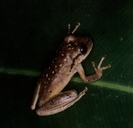|
Description
Males 28-31 mm, females 32 mm. The dorsum is dark brown with many light brown or white spots, that may be orange during the day. A dark line extends from the nostrils to the posterior region of the tympanum. The belly is white, and the throat region is cream to yellowish. Distribution and Habitat
Country distribution from AmphibiaWeb's database: Brazil, French Guiana, Suriname, Venezuela
Common close to large streams in open areas and near the edge of the Reserva Florestal Adolpho Ducke in Brazil.Life History, Abundance, Activity, and Special Behaviors
The species is arboreal and nocturnal. Males call from leaf-litter or shrubs near ponds. Reproduction occurs in the rainy season (November to May). Clutches containing about 600 eggs deposited in the water. Tadpoles are freeswimming and complete development in ponds. Comments
Similar species: Scinax ruber can be distinguished by the yellow or orange spots on a black background on its thighs; and the lack of a dark line from nostril to the posterior region of tympanum. Male S. ruber are yellow when calling.
Originally submitted by: Albertina P. Lima, William E. Magnusson, Marcelo Menin, Luciana K. Erdtmann, Domingos J. Rodrigues, Claudia Keller, Walter Hödl (first posted 2007-11-27)
Edited by: Kellie Whittaker (2007-11-28)Species Account Citation: AmphibiaWeb 2007 Scinax boesemani <https://amphibiaweb.org/species/1093> University of California, Berkeley, CA, USA. Accessed Jun 7, 2025.
Feedback or comments about this page.
Citation: AmphibiaWeb. 2025. <https://amphibiaweb.org> University of California, Berkeley, CA, USA. Accessed 7 Jun 2025.
AmphibiaWeb's policy on data use.
|
